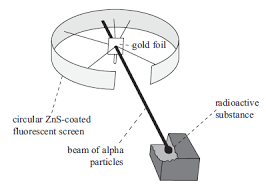
Concept explainers
Interpretation:
The discovery of the nucleus by Rutherford needs to be explained.
Concept introduction:
A radioactive source emits alpha particles (positively charged particles). Like charges repels each other and unlike charges attract.
Answer to Problem 51A
In the Rutherford experiment, the radioactive particle was used to detect the direction of the beam and its nature. The center portion is known as the nucleus.
Explanation of Solution
Rutherford set up the experiment as the alpha particle goes in high speed. A small slit in the screen makes the alpha particle able to stuck in. The alpha particle would penetrate the gold foil. Alpha particles are positive. So they get repel by the positive region but it was found that some part of a beam goes in a straight-line, some have deviated from its path, and some reverse to the sources.
It explains that only a small region at the center point is positive. And it is discovered as the nucleus of an atom. All of the positive charges of protons and all mass of an atom are concentrated in a very small area and the remaining region of the atom is mostly empty.
 Gold foil experiment
Gold foil experiment
- Alpha particles went straight through gold foil suggested that atom mostly composed of open space consisting of negatively charged particles know as electrons.
- Alpha particles deflected slightly were passed by touching any positively charged particle.
- Alpha particles bounced back toward the source have encountered with a positively charged and heavy particle known as the nucleus.
Chapter 4 Solutions
Chemistry: Matter and Change
Additional Science Textbook Solutions
Chemistry: Structure and Properties
CHEMISTRY-TEXT
General, Organic, and Biological Chemistry (3rd Edition)
Organic Chemistry
Chemistry: A Molecular Approach (4th Edition)
Chemistry: The Central Science (14th Edition)
 ChemistryChemistryISBN:9781305957404Author:Steven S. Zumdahl, Susan A. Zumdahl, Donald J. DeCostePublisher:Cengage Learning
ChemistryChemistryISBN:9781305957404Author:Steven S. Zumdahl, Susan A. Zumdahl, Donald J. DeCostePublisher:Cengage Learning ChemistryChemistryISBN:9781259911156Author:Raymond Chang Dr., Jason Overby ProfessorPublisher:McGraw-Hill Education
ChemistryChemistryISBN:9781259911156Author:Raymond Chang Dr., Jason Overby ProfessorPublisher:McGraw-Hill Education Principles of Instrumental AnalysisChemistryISBN:9781305577213Author:Douglas A. Skoog, F. James Holler, Stanley R. CrouchPublisher:Cengage Learning
Principles of Instrumental AnalysisChemistryISBN:9781305577213Author:Douglas A. Skoog, F. James Holler, Stanley R. CrouchPublisher:Cengage Learning Organic ChemistryChemistryISBN:9780078021558Author:Janice Gorzynski Smith Dr.Publisher:McGraw-Hill Education
Organic ChemistryChemistryISBN:9780078021558Author:Janice Gorzynski Smith Dr.Publisher:McGraw-Hill Education Chemistry: Principles and ReactionsChemistryISBN:9781305079373Author:William L. Masterton, Cecile N. HurleyPublisher:Cengage Learning
Chemistry: Principles and ReactionsChemistryISBN:9781305079373Author:William L. Masterton, Cecile N. HurleyPublisher:Cengage Learning Elementary Principles of Chemical Processes, Bind...ChemistryISBN:9781118431221Author:Richard M. Felder, Ronald W. Rousseau, Lisa G. BullardPublisher:WILEY
Elementary Principles of Chemical Processes, Bind...ChemistryISBN:9781118431221Author:Richard M. Felder, Ronald W. Rousseau, Lisa G. BullardPublisher:WILEY





